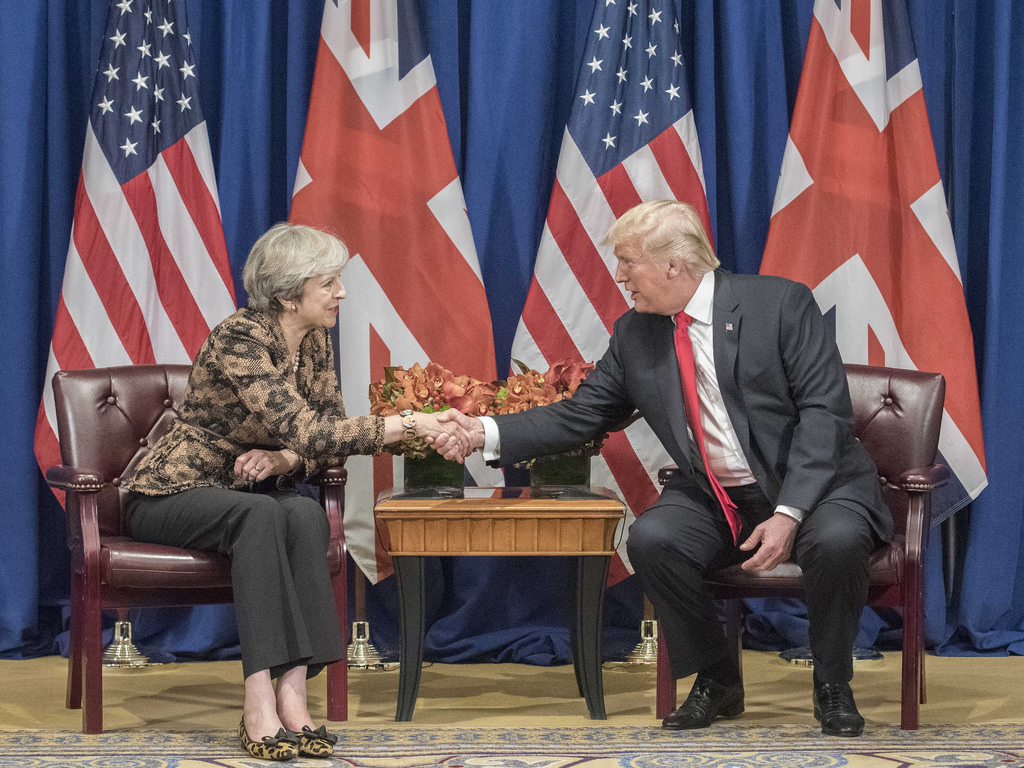1. Theresa May
What a year the prime minister has had. An election she won but also basically lost, Brexit negotiations that she’s pretty much losing but claims she’ll ultimately win, and a climate action agenda that despite her recent strong words still seems pretty uncertain at best.
As May is keen to point out, on her watch the UK has reaffirmed a pledge to phase-out coal by 2025, the UK had a coal free day for the first time since the industrial revolution, and the government has made some positive noises about electric vehicles.
But at the same time, members of her party having been busy meeting with climate science deniers in the US, and continue to push disinformation about climate change in the national media. And that’s not to mention what Brexit could do to the UK’s environmental regulations.
2. Jeremy Corbyn
Her weekly opponent at PMQs has also had quite a year – losing an election he kind of won, and continuing to make Labour look like the green alternative (if you, perhaps unfairly, exclude the erm… Greens).
The Labour manifesto said the Conservatives “broke their promise to be the ‘greenest government ever’”, and pledged to ban fracking and introduce a Clean Air Act. Labour shadow chancellor John McDonnell even made time to visit the anti-fracking protests at Preston New Road in September.
In contrast, May’s party manifesto said the Conservatives would keep working to build a UK shale gas industry, as well as reiterating the party’s commitment to maximising recovery of North Sea oil and gas reserves.
3. Sammy Wilson
As a result of Corbyn’s unexpected popularity, or May’s unexpected instability, the Conservatives had to cut a deal with Northern Ireland’s Democratic Unionist Party (DUP).
One of the DUP’s 10 MPs that currently hold the balance of power in Westminster is Sammy Wilson – representative for East Antrim and a well-known climate science denier.
Earlier this year, he welcomed President Donald Trump’s decision to pull the US out of the Paris Agreement. In a statement published on Wilson’s website, he said:
“The Paris Agreement itself is a delusion,” adding, “…pulling out of the agreement which was only a piece of window dressing for climate chancers who wished to pretend that they were doing something about an issue which they can’t affect anyhow is not the disaster which the green lefties are getting hysterical about.”
Wilson also sits at the heart of a network of pro-Brexit climate science deniers spanning the US and the UK, having helped organise numerous climate disinformation events in parliaments over the course of his career.
4. Michael Gove
This year has been topsy turvy for Michael Gove. A failed leadership bid (via a very political coup) and his hardline Brexit stance made him persona non grata in May’s early cabinet. But his Brexiteer profile and lack of fear of standing up to Boris Johnson saw him brought back into the fold in July — as Environment Secretary no less.
This made more than a few environmentalists jumpy, given his slightly suspect history on green policies.
In 2013, while education secretary, Gove tried to exclude climate change from the geography national curriculum but abandoned his plans after intense pressure from then energy secretary Ed Davey. Then, in December 2014, Gove, as Tory chief whip, barred the new energy and climate secretary Amber Rudd from attending the UN climate negotiations in Lima, Peru.
At the Conservative party conference in October, he told a packed side event that he is convinced “climate change is a danger” but that efforts to cut greenhouse gas emissions must not come at the expense of economic growth.
5. Claire Perry
Another new, less familiar, face in Theresa May’s cabinet is climate minister Claire Perry.
Perry has a patchy voting record on climate change. She voted against measures to tackle the issue 11 times since she joined parliament in 2011, according to records from TheyWorkForYou.
She made a strong statement, however, in favour of implementing policies to address climate change on her website in an entry from 11 February 2016, calling it “one of the most serious threats that we face”.
In the same statement, she also said she hopes “to see an ambitious set of targets, that are balanced with keeping costs affordable for consumers” in the government’s long-awaited emission reduction plan.
Her main action of note since becoming climate minister was to stand alongside Canadian environment minister, Catherine McKenna, at the UN climate talks in Bonn this year to reaffirm the UK’s commitment to phasing out coal.
Perry is more keen on the UK’s membership of the EU than many of May’s recent appointments. She was one of seven MPs to rebel against the government and vote for a clause that would have required May to get parliamentary approval for any Brexit deal. The clause was still defeated by 326 votes to 293.
6. Liam Fox
At the other end of the spectrum to Perry — in both his views on Brexit and approach to climate policy — is international trade secretary, Liam Fox.
Fox continued 2017 pretty much as he had approached 2016.
He met with two neoconservative think tanks during his first trip to the United States after the 2017 general election. According to documents obtained by DeSmog UK via the Freedom of Information Act, Fox held a breakfast meeting with think tanks and business associations in Washington D.C. during his trip on 19-20 June. In attendance was the American Enterprise Institute (AEI) and the Heritage Foundation – both influential think tanks backed by corporations and conservative foundations.
In 2016, during his first post-Brexit trip to the United States, less than two weeks after being appointed International Trade Secretary, Fox addressed 16 Heritage Foundation staff, including the think tank’s president Jim DeMint, and executive vice president, Bret Bernhardt, over lunch “to explain the formation of the Department and UK priorities on trade and our EU renegotiation”, according to the meeting notes.
Fox is at the core of a transatlantic Brexiteer climate science denier network, previously mapped by DeSmog UK.
7. Daniel Hannan
Another member of that network, Daniel Hannan, has continued his rise to prominence in 2017.
Since the Brexit referendum set the clock ticking on his current job as a Member of the European Parliament for the South East, Hannan has been busy carving a new identity for himself as a voice for free trade.
In September, Hannan launched the Institute for Free Trade at the UK’s Foreign Office. Trade Secretary Liam Fox and Foreign Secretary Boris Johnson both spoke at the launch event.
And in February, Hannan hosted the ‘Blue-Green Summit’ conference in Brussels. On the programme were climate science denier and GWPF advisor Matt Ridley and Myron Ebell, the former head of President Trump’s Environmental Protection Agency (EPA) transition team and a director of the libertarian US think tank the Competitive Enterprise Institute (CEI). Climate denier and UKIP MEP Roger Helmer and the GWPF’s director Benny Peiser were also in attendance.
8. David Rose
Another GWPF-favourite, journalist David Rose, has also had a slightly tricky year.
In February, in an “exclusive” for the Mail on Sunday making a number of inflammatory claims about the background to a scientific paper, published in the journal Science, which updated global temperature data to account for changes in the way ocean temperature measurements were taken.
Scientists and other journalists discovered several major flaws in Rose’s story.
Climate Home spoke to several UN climate negotiators, who explained the paper, led by Dr Thomas Karl, of NOAA, had no influence on the Paris talks. A factcheck at Carbon Brief by Berkeley Earth climate scientist Zeke Hausfather showed how Rose had ignored other scientific articles which had confirmed the work done by Karl et al. The claim that the Karl paper was “rushed” was refuted by the editor of Science, who revealed that in fact that paper had taken longer than usual to go through peer review at the journal.
In September, the Mail on Sunday was forced to publish a prominent correction to the story by press regulator IPSO. It ruled that the Mail on Sunday had “failed to take care over the accuracy of the article” and “had then failed to correct these significantly misleading statements”.
Rose ended the year with a hatchet-job feature for the same outlet on the Preston New Road anti-fracking protesters – this is despite not confirming whether he ever visited the sites.
9. Preston New Road protesters
For almost a year now, there has been a rolling protest outside the gates of the UK’s most infamous fracking site, at Preston New Road in Lancashire.
Local and non-local campaigners have now spent nearly a year protesting against communities secretary Sajid Javid’s decision to overrule the local council and allow Cuadrilla to explore for shale gas.
In July, Cuadrilla breached its planning permission with the cooperation of police to bring a drill onto the site – just a few days after a month of campaign action at the site had concluded.
The gradual rise in tension between protesters, Cuadrilla’s staff, and the police led to watchdog Netpol to call for an “urgent review” into the policing of fracking protests across the UK.
10. Scientists and Science Geeks on the March for Science
A rather different set of protesters took to the streets in April on the March for Science, calling on governments across the world to do their bit to ensure evidence-based policy making.
Between 7,500 and 10,000 people came out to march three miles from London’s famous Science Museum to the House of Parliament to ask the government to support scientific enquiry in the UK.
The march was part of a global action, with over 500 marches taking place across the globe — from spots as far apart as Washington DC and Sao Paulo, Helsinki and Brisbane.
The March for Science’s aim was to persuade policymakers of the benefits of “robustly funded and publicly communicated science as a pillar of human freedom and prosperity”, according to the event’s website.
11. Donald Trump
One of the main targets of the scientists’ ire — and an obvious place to end this list — was of course the President of the United States, Donald Trump.
Trump withdrew the US from the Paris Agreement, generally put a downer on the UN climate talks, and most recently set about removing climate change from the country’s national security plan.
Meanwhile, the man who led his transition team on energy and environment — Myron Ebell — continued to strengthen his ties with UK climate disinformation campaigners.
The UK Foreign and Commonwealth Office (FCO) was in touch with climate science denier Myron Ebell during his time as head of the US Environmental Protection Agency (EPA) transition team, according to a Freedom of Information Request reported by DeSmog UK in May.
Ebell also appeared alongside the director of climate science denial campaign group, the Global Warming Policy Foundation, Benny Peiser in January. A few days later he sat alongside GWPF advisor and famous purveyor of climate disinformation Lord Matt Ridley at an event in Brussels, hosted by Brexit cheerleader Daniel Hannan. And in October he met with former environment secretary and Conservative MP Owen Paterson.
But amidst the anti-climate science atmosphere in the US, French President Macron has seized the opportunity to try and position France as a global leader in tackling climate change. The year came to a close with Macron hosting the One Planet climate summit in Paris in December on the two-year anniversary of the Paris agreement making him one face to watch in 2018.
Photo: Number 10 via Flickr | CC2.0
Subscribe to our newsletter
Stay up to date with DeSmog news and alerts






